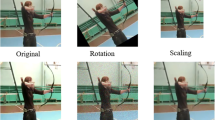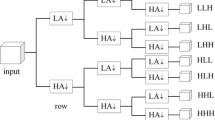Abstract
This study proposes a robust video hashing for video copy detection. The proposed method, which is based on representative-dispersive frames (R-D frames), can reveal the global and local information of a video. In this method, a video is represented as a graph with frames as vertices. A similarity measure is proposed to calculate the weights between edges. To select R-D frames, the adjacency matrix of the generated graph is constructed, and the adjacency number of each vertex is calculated, and then some vertices that represent the R-D frames of the video are selected. To reveal the temporal and spatial information of the video, all R-D frames are scanned to constitute an image called video tomography image, the fourth-order cumulant of which is calculated to generate a hash sequence that can inherently describe the corresponding video. Experimental results show that the proposed video hashing is resistant to geometric attacks on frames and channel impairments on transmission.
Similar content being viewed by others
References
Cox I, Kilian J, Leighton F, et al. Secure spread spectrum watermarking for multimedia. IEEE Trans Image Process, 1997, 6: 1673–1687
Hartung F, Kutter M. Multimedia watermarking techniques. Proc IEEE, 1999, 87: 1079–1107
Joly A, Buisson O, Frelicot C. Content-based copy retrieval using distortion-based probabilistic similarity search. IEEE Trans Multimedia, 2007, 9: 293–306
Lee S, Yoo C D. Video fingerprinting based on centroids of gradient orientations. In: Proceedings of IEEE International Conference on Acoustics, Speech and Signal Processing, Toulouse, 2006. 401–404
Zhou X B, Schmucker M, Christopher L. Perceptual hashing of video content based on differential block similarity. In: Proceedings of the International Conference on Computational Intelligence and Security, Xi’an, 2005. 80–85
Coskun B, Sankur B, Memon N. Spatio-temporal transform based video hashing. IEEE Trans Multimedia, 2006, 8: 1190–1208
Esmaeili M M, Fatourechi M, Ward R K. A robust and fast video copy detection system using content-based fingerprinting. IEEE Trans Inf Forensic Secur, 2011, 6: 213–216
Law T J, Chen L, Joly A, et al. Video copy detection: a comparative study. In: Proceedings of the 6th ACM International Conference on Image and Video Retrieval, Amsterdam, 2007. 371–378
Xiang S J, Yang J Q, Huang J W. Perceptual video hashing robust against geometric distortions. Sci China Inf Sci, 2012, 55: 1520–1527
Li W, Preneel B. From image hashing to video hashing. In: Proceedings of the 16th International Multimedia Modeling Conference, Chongqing, 2010. 662–668
Nie X S, Liu J, Sun J D. Robust video hashing for identification based on MDS. In: Proceedings of the IEEE International Conference on Acoustics Speech and Signal Processing (ICASSP), Dallas, 2010. 1834–1837
Nie X S, Liu J, Sun J D, et al. Robust video hashing based on double-layer embedding. IEEE Signal Process Lett, 2011, 18: 307–310
Wei Z K, Zhao Y, Zhu C, et al. Frame fusion for video copy detection. IEEE Trans Circuits Syst Video Technol, 2011, 21: 15–28
Douze M, Jegou H, Schmid C. An image-based approach to video copy detection with spatio-temporal post-filtering. IEEE Trans Multimedia, 2010, 12: 257–266
Sun J D, Wang J, Zhang J, et al. Video hashing algorithm with weighted matching based on visual saliency. IEEE Signal Process Lett, 2012, 19: 328–331
Wang J, Sun J D, Liu J, et al. A visual saliency based video hashing algorithm. In: Proceedings of the IEEE International Conference on Image Processing (ICIP), Orlando, 2012. 645–648
Akutsu A, Tonomura Y. Video tomography: An efficient method for camerawork extraction and motion analysis. In: Proceedings of the ACM International Conference on Multimedia. New York: ACM, 1994. 349–356
Yu L J, Schmucker M, Busch C, et al. Cumulant-based image fingerprints. In: Proceedings of SPIE-Security, Steganography, and Watermarking of Multimedia Contents, San Jose, 2005. 68–75
Varna A L, Swaminathan A, Wu M. A decision theoretic framework for analyzing binary hash-based content identification systems. In: Proceedings of the ACM Conference on Computer and Communications Security. New York: ACM, 2008. 67–76
Oostveen J C, Kalker T, Haitsma J. Visual hashing of digital video: Applications and techniques. In: Proceedings of SPIE—Storage and Retrieval for Image and Video Databases, San Diego, 2001. 121–131
Author information
Authors and Affiliations
Corresponding author
Rights and permissions
About this article
Cite this article
Nie, X., Liu, J., Sun, J. et al. Robust video hashing based on representative-dispersive frames. Sci. China Inf. Sci. 56, 1–11 (2013). https://doi.org/10.1007/s11432-012-4760-y
Received:
Accepted:
Published:
Issue Date:
DOI: https://doi.org/10.1007/s11432-012-4760-y




